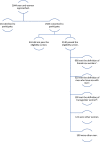The burden of HIV among female sex workers, men who have sex with men and transgender women in Haiti: results from the 2016 Priorities for Local AIDS Control Efforts (PLACE) study
- PMID: 31287624
- PMCID: PMC6615490
- DOI: 10.1002/jia2.25281
The burden of HIV among female sex workers, men who have sex with men and transgender women in Haiti: results from the 2016 Priorities for Local AIDS Control Efforts (PLACE) study
Abstract
Introduction: Despite the higher risk of HIV among female sex workers (FSWs), men who have sex with men (MSM) and transgender women (TGW), these populations are under-represented in the literature on HIV in Haiti. Here, we present the first nationally representative estimates of HIV prevalence and the first care and treatment cascade for FSWs, MSM and TGW in Haiti. We also examine the social determinants of HIV prevalence in these groups and estimate FSW and MSM population size in Haiti.
Methods: Data were collected between April 2016 and February 2017 throughout the 10 geographical departments of Haiti. The Priorities for Local AIDS Control Efforts (PLACE) method was used to: (1) recruit participants for a behavioural survey; (2) provide rapid testing, counselling and linkage to care for syphilis and HIV; and (3) measure viral load using dried blood spots for participants testing HIV positive.
Results: Study participants included 990 FSWs, 520 MSM and 109 TGW. HIV prevalence was estimated at 7.7% (95% CI 6.2%, 9.6%) among FSWs, 2.2% (0.9%, 5.3%) among MSM and 27.6% (5.0%, 73.5%) among TGW. Of participants who tested positive for syphilis, 17% of FSWs, 19% of MSM and 74% of TGW were co-infected with HIV. Economic instability and intimate partner violence (IPV) were significantly associated with HIV among MSM; food insecurity, economic instability and history of rape were significantly associated with HIV among TGW. Fewer than one-third of participants living with HIV knew their status, and more than a quarter of those who knew their status were not on treatment. While approximately four in five FSW and MSM participants on treatment for HIV were virally suppressed, viral suppression was less common among TGW participants at only 46%.
Conclusions: This study demonstrates a need for targeted interventions to prevent and treat HIV among key populations in Haiti. Potential high-impact interventions may include venue-based, peer navigator-led outreach and testing for HIV and syphilis and improving screening and case management for structural violence and IPV. TGW are in urgent need of such interventions due to our observations of alarmingly high HIV prevalence and low frequency of HIV viral suppression among TGW.
Keywords: Caribbean; Haiti; men who have sex with men; sex workers; transgender people; viral suppression.
© 2019 The Authors. Journal of the International AIDS Society published by John Wiley & Sons Ltd on behalf of the International AIDS Society.
Figures


References
-
- Institut Haïtien de l'Enfance (IHE) and ICF . 2017. Enquête Mortalité, Morbidité et Utilisation des Services, Haïti, 2016‐2017: indicateurs Clés. Rockville, Maryland, and PétionVille, Haiti: IHE et ICF .
-
- Pan Caribbean Partnership against HIV and AIDS (PANCAP) . Caribbean Regional Strategic Framework on HIV and AIDS 2014‐2016. 2014. [cited 2018 Aug 30]. Available from: http://www.pancap.org/docs/Final%20CRSF%202014-2018_FINAL.pdf
-
- Figueroa JP. Review of HIV in the Caribbean: significant progress and outstanding challenges. Current HIV/AIDS Reports. 2014;11:158–67. - PubMed
-
- UNAIDS . 90‐90‐90: an ambitious treatment target to help end the AIDS epidemic. 2014. [cited 2018 Aug 30]. Available from: http://www.unaids.org/sites/default/files/media_asset/90-90-90_en.pdf
Publication types
MeSH terms
Substances
Grants and funding
LinkOut - more resources
Full Text Sources
Medical
Miscellaneous

